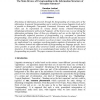Free Online Productivity Tools
i2Speak
i2Symbol
i2OCR
iTex2Img
iWeb2Print
iWeb2Shot
i2Type
iPdf2Split
iPdf2Merge
i2Bopomofo
i2Arabic
i2Style
i2Image
i2PDF
iLatex2Rtf
Sci2ools
TBILLC
2005
Springer
2005
Springer
The Main Devices of Foregrounding in the Information Structure of Georgian Sentences
Structuring of information proceeds through the foregrounding of certain parts of the information. In general, foregrounding can be realized on various linguistic levels and it is possible to distinguish: Conceptual, Functional, Discourse and Pragmatic devices, which can be represented by various formal means: Phonetic-Phonological, Morphological-Syntactic and Lexical-Pragmatic. All the devices can co-occur during the information packaging. Some of them are obligatory and are on the high level of the hierarchically organized processes of foregrounding (e.g. conceptual or functional foregrounding); some of them are optional and they are defined by the specific discourse and/or pragmatic values of a sentence (e.g. focus or topic); some forms of foregrounding are implicational (e.g. sometimes reordering implies emphasis of intonation) and so on. The relations between the different kinds of foregrounding are language specific, but it seems possible to speak about universal models of forma...
| Added | 28 Jun 2010 |
| Updated | 28 Jun 2010 |
| Type | Conference |
| Year | 2005 |
| Where | TBILLC |
| Authors | Rusudan Asatiani |
Comments (0)

